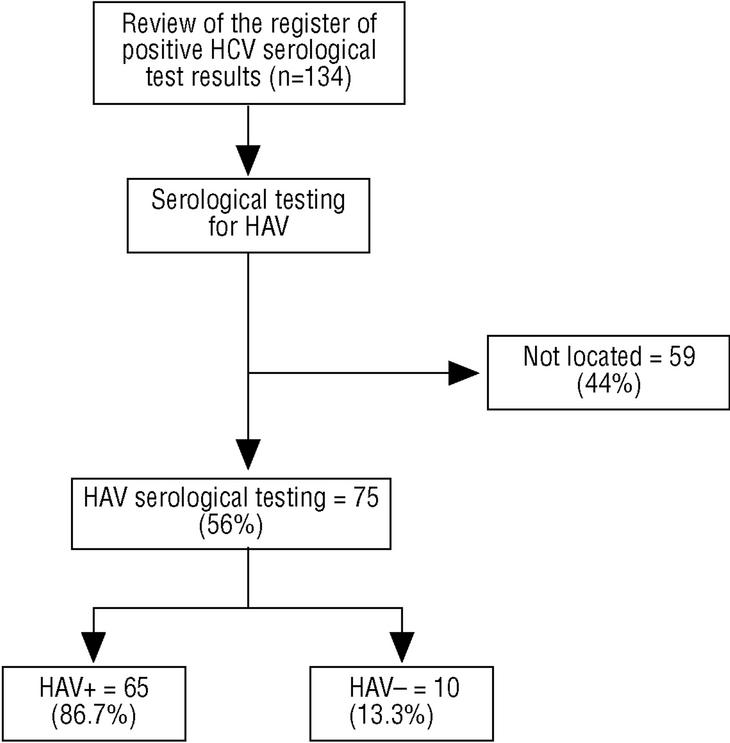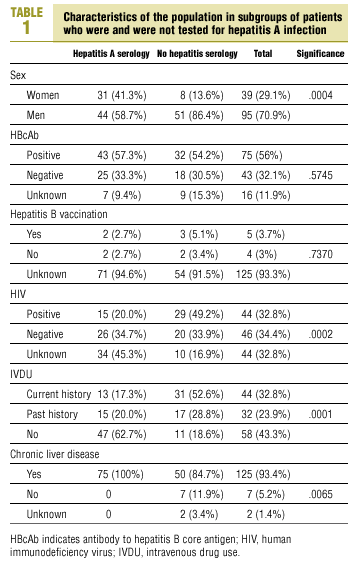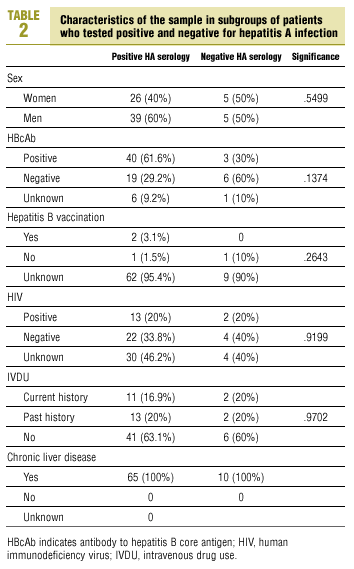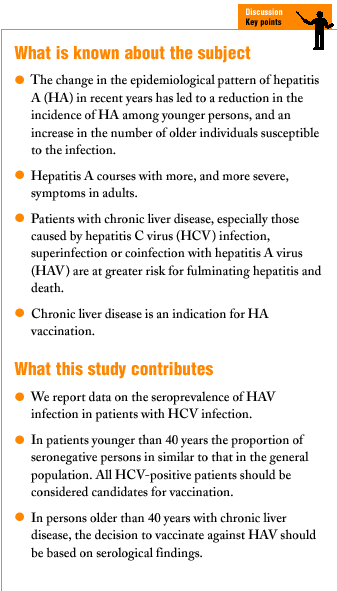Introduction
Recent years have seen a change in the epidemiological pattern of hepatitis A (HA). Epidemiological studies in Spain based on serological analyses carried out between 1977 and 1996 have shown a significant decrease in the prevalence of anti-HA antibodies in younger age groups.
In persons aged 11-14 years, the prevalence declined from 49% in 1977 to 30% in 1985, and to 4.6% in 1996. In persons aged 21-30 years the prevalence declined from 73% in 1977 to 58.5% in 1985. In 1996 the figure was 29.1% for persons 20-24 years old, and 42% for those aged 25-30 years. These data reflect a reduction in the incidence of HA in younger persons, and an increase in the number of persons susceptible to infection in older age groups, in which the disease is known to course with more, and more severe, symptoms.1-9
This change in the epidemiological pattern is also of relevance because of its implications for patients with chronic liver disease, mainly that caused by hepatitis C virus (HCV), as in these patients, superinfection or coinfection with hepatitis A virus (HAV) implies an increased risk of fulminant hepatitis or death.10-13 In these groups of patients vaccination against HAV is recommended as a preventive measure, and has been shown to be effective in preventing infection.14-18
The aim of this study was to investigate the prevalence of immunization against HAV in persons with HCV infection, in order to identify susceptible individuals who could potentially benefit from HAV vaccination.
Material and methods
The study was done at the Dr. Pujol y Capsada Health Center, an urban center located in El Prat de Llobregat (Barcelona province, Spain) serving a population of 12 000. The socioeconomic level of most inhabitants is low, and approximately 20% of the inhabitants are members of the Gypsy ethnic group.
This descriptive, cross-sectional study was done between May 1999 and March 2000 and involved the population of individuals older than 14 years who were seen at this health center. Patients were initially identified from a computerized register of cases of chronic liver disease, persons with human immunodeficiency virus (HIV) infection or intravenous drug users (IVDU), and from the register of serological laboratory tests ordered during the previous 2 years to detect persons positive for HCV infection. The medical records of these patients were reviewed, and HAV serological testing was requested for those patients who had not undergone such testing. These patients were contacted in the course of a visit to the health center, by telephone or in writing.
The variables analyzed in this study were age, sex, presence of chronic liver disease, laboratory results for hepatitis B (HBcAb), hepatitis A (IgG, classified as positive or negative on the basis of the laboratory reference value), antecedents of vaccination for HB, intravenous drug use, and the results of serological testing for HIV (if such testing had been done).
The prevalence of immunization against HAV was analyzed in patients with HCV infection diagnosed at any time during their life.
The SPSS-PC software was used to generate descriptive statistics for the variables, with P<.05 used to indicate statistical significance. 95% confidence intervals were calculated for the main findings. Chi-squared and Student´s t tests were used for the bivariate analysis.
Results
Of the patients we studied, 134 were HCV-positive. Men made up 70.9% of this group (95% CI, 63.2%-78.6%), and 29.1% were women (95% CI, 21.4%-36.8%). Mean age was 41.75 years (SD, 16.55 years). Chronic liver disease was present in 93.3% (95% CI, 89%-97.5%), IVDU was recorded in 56.7% (95% CI, 48.3%-65.1%), HBcAb positivity was found in 56% (95% CI, 47.6%-64.4%), and HIV positivity was found in 32.8% (95% CI, 24.9%-40.8%) (Table 1).
Immunity to HA was tested in 75 patients (56%). The response to the request for testing was better in women, HIV-negative persons, persons with no history of IVDU, and persons with chronic liver disease (Table 1).
Of the 59 patients (44%) in whom HA immunity could not be tested, 84.7% (95% CI, 75.6%-93.9%) did not respond to attempts to contact them by phone or in writing, 13.6% (95% CI, 4.8%-22.3%) were temporarily absent from their home (in prison or in a detoxification center, or away on holiday), and 1 patient (1.7%; 95% CI, 0%-5%) declined to be tested.
Mean age of the patients who were tested for HA immunity was 48.4 years (SD, 18 years); mean age in the group who did not undergo serological testing was 33.3 years (SD, 9.3 years; P<.0001). Of patients with a current or previous history of IVDU, or who were positive for HIV, 37.8% agreed to be tested, vs. 84.6% of the patients with neither of these antecedents (P=.0001). There were no significant differences in the prevalence of HAV infection between these groups (83.9% in the former group vs. 88.6% in all other patients).
Serological tests for HA were positive in 86.7% (95% CI, 79.0%-94.4%) and negative in 13.3% (95% CI, 6.0%-21.0%). Mean age in the former group was 50.17 years (SD, 17.8 years), and mean age in the latter was 36.6 years (SD, 15.0 years; P=.02). The prevalence of seropositivity among patients younger than 40 years was 75.7% (95% CI, 61.9%-89.5%), vs. 97.5% (95% CI, 92.3%-100%) in older patients (P=.006). Table 2 summarizes the characteristics in patients who were positive and negative for HAV; no statistically significant differences were found.
Discussion
La prevalencia de inmunización frente al VHA en pacientes infectados por el VHC es de un 86,5% en la muestra The prevalence of immunization against HAV in patients with HCV infection was 86.5% in the sample of persons we studied. This figure is similar to that reported in 1998 by Diago et al for a Valencian population. These authors studied patients hospitalized with chronic liver disease caused by HBV and HCV, who were similar in age to the population we studied. The prevalence of HAV infection in their study ranged from 75% to 90%1.
Our sample did not differ in terms of sex, age or seroprevalence of HB in comparison to other studies1,10, although the percentage of patients with a history of IVDU was higher in our sample than in the study by Diago et al.1 Coinfection with HIV could not be compared with earlier studies, as we found none that had investigated this factor.
In the present study, most of the patients who declined HAV testing were HIV carriers or had a history of IVDU (62.2% of these patients refused testing), as compared to a refusal rate of 15.4% among all remaining patients. This response may reflect problems in locating the patients, and the tendency of these patients to reject preventive health interventions.
The population we studied contained a high percentage of persons who were positive for HIV infection or who had a current or prior history of IVDU, and the prevalence of HAV infection might be expected to be higher in this group. However, we found no difference in the rate of HAV infection between the patients with these two antecedents and those without them.
Vaccination against HA is indicated for patients with chronic liver disease, and vaccination should be given systematically if the patient is seronegative.14-19
In the present study we found a higher proportion of HAV seronegative patients among those younger than 40 years, in whom seroprevalence was similar to that reported for patients aged 30-39 years in the general population (77.3%; 95% CI, 72.9%-81.8%).4,5 These figures mean that vaccination against HA should be recommended for all HCV-positive patients younger than 40 years, and for patients of any age with chronic liver disease who are seronegative.
Cost-benefit studies will be needed to determine whether serological testing should be done before vaccination in different age groups.
Correspondence: Alicia Ezpeleta. ABS Dr. Pujol i Capsada. C/ Riu Anoia, 19. 08820 El Prat de Llobregat (Barcelona). España. E-mail: pcapsada@baixll.scs.es















